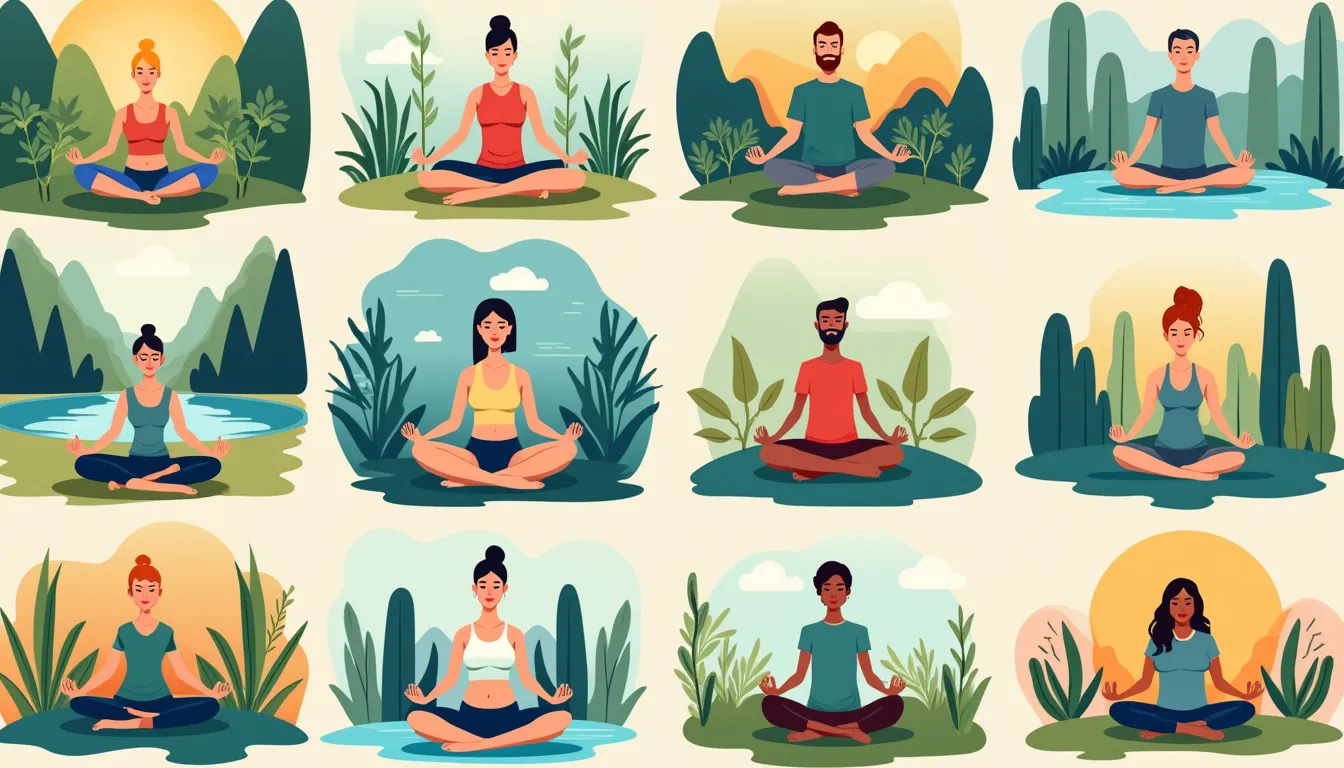Meditation serves as a cornerstone of spiritual practice, offering a pathway to inner peace, heightened awareness, and profound personal insight. For centuries, various cultures and spiritual traditions have embraced meditation as a means to transcend the mundane and connect with a higher state of consciousness. In the journey toward spiritual growth, selecting the right meditation technique is essential. The myriad of meditation styles available can cater to individual preferences, allowing practitioners to deepen their spiritual practice in a way that resonates with their unique needs and beliefs.
Setting an intention is the first step in any meaningful meditation practice. It involves committing to a spiritual journey with the purpose of enhancing inner peace, compassion, and self-awareness. By doing so, you align your practices with a higher goal, giving your meditation sessions a clearer focus and greater depth. In this comprehensive guide, we will explore ten diverse meditation techniques that can enrich your spiritual path, from mindfulness and loving-kindness to transcendental and sound meditation. Each technique presents unique benefits and methods, ensuring that there is something for everyone, irrespective of where they are on their spiritual journey. Whether you are a seasoned practitioner or new to meditation, these techniques provide valuable tools to deepen your spiritual practice and foster a more profound connection with your inner self.
Introduction to Meditation and Spiritual Practice
Meditation is an ancient practice that has been used for centuries to cultivate a deeper connection with one’s inner self, promote mental clarity, and foster spiritual growth. In today’s fast-paced world, engaging in meditation can provide a much-needed respite from daily stressors, allowing individuals to explore their spirituality in a meaningful and profound way. Understanding the role of meditation in spiritual growth can help you choose the right technique that aligns with your personal spiritual journey.
The Role of Meditation in Spiritual Growth
At its core, meditation allows individuals to transcend the superficial layers of everyday consciousness and connect with their true essence. This connection initiates a journey of self-discovery, offering insights into the nature of existence and one’s place within the universe. Through regular meditation practice, individuals can experience a heightened state of awareness, inner peace, and spiritual enlightenment.
One of the primary functions of meditation in spiritual practice is to quiet the mind and open the heart. As thoughts become less turbulent, the meditative state creates a space for deeper spiritual understanding and connection. This transformative process can lead to profound realizations, fostering a sense of wholeness and oneness with all that is.
The Importance of Choosing the Right Meditation Technique
Not all meditation techniques are created equal, and what works for one person may not necessarily work for another. Therefore, it is important to explore different meditation methods to find the one that resonates most with your spiritual goals and personal preferences. Choosing the right meditation technique can enhance your spiritual practice by aligning with your inner needs, supporting your unique journey, and providing the specific benefits you seek.
For instance, some individuals may find profound spiritual awakening through mindfulness meditation, while others may experience a deeper connection to their spirituality through chanting mantras or practicing transcendental meditation. By exploring various techniques, you can discover the one that facilitates the deepest sense of spiritual growth and fulfillment.
Setting the Intention for Deepening Your Spiritual Journey
Before diving into the different meditation techniques, it’s essential to set a clear intention for your spiritual journey. Intentions act as guiding principles, focusing your energy and aligning your practice with your desired spiritual outcomes. When setting your intention, consider the following:
- Reflect on Your Spiritual Goals: Take time to contemplate what you hope to achieve through meditation. Are you seeking inner peace, greater self-awareness, a strong connection to the divine, or perhaps something else?
- Create a Dedicated Space: Establish a tranquil and sacred space in your home where you can meditate without distractions. This space will serve as a physical reminder of your commitment to your spiritual practice.
- Be Open and Patient: Spiritual growth is a journey that unfolds over time. Embrace the process with an open heart and be patient with yourself as you progress.
- Commit to Consistency: Regular practice is key to deepening your meditation experience. Set aside dedicated time each day, even if it’s just a few minutes, to sit in meditation and connect with your inner self.
Setting a clear intention not only provides direction but also amplifies the spiritual power of your meditation practice. With a well-defined purpose, each meditation session becomes a step towards achieving your spiritual aspirations.
Benefits of Deepening Your Spiritual Practice Through Meditation
Deepening your spiritual practice through meditation offers numerous benefits that extend beyond the meditative experience itself. Here are some of the key advantages:
- Enhanced Self-Awareness: Regular meditation helps you develop a greater understanding of your thoughts, emotions, and behaviors, leading to improved self-awareness.
- Inner Peace and Calming of the Mind: Meditation reduces mental chatter and promotes a sense of tranquility, allowing you to experience inner peace even amidst life’s challenges.
- Spiritual Connection: By quieting the mind and opening the heart, meditation facilitates a deeper connection with your higher self and the divine.
- Emotional Healing: Meditation can help release unresolved emotions and traumas, leading to emotional healing and personal growth.
- Heightened Intuition: As you deepen your meditation practice, you may experience a heightened sense of intuition, gaining clarity and insight into your life’s purpose.
- Greater Compassion and Empathy: Meditation fosters empathy and compassion by helping you connect with the experiences and emotions of others.
As you embark on your journey to deepen your spiritual practice through meditation, remember that the path is unique for each individual. Embrace the process with an open heart and a willingness to explore various techniques until you find the one that resonates most with your spirit.

Top 10 Meditation Techniques
Mindfulness Meditation
Mindfulness meditation encourages the meditator to focus on the breath. is a practice rooted in paying deliberate attention to your sensations, feelings, and thoughts in the present moment, without judgment. It involves being fully present, acknowledging what is going on inside and around you with an accepting attitude. This type of meditation that can help you go deeper into your inner self. has significant benefits for spiritual growth, including increased self-awareness, enhanced emotional regulation, and a deeper connection to the present moment.
To practice mindfulness meditation, follow these best meditation techniques for beginners:
- Find a quiet, comfortable space where you won’t be disturbed.
- Sit in a comfortable position with your back straight and your hands resting on your lap.
- Close your eyes and take a few deep breaths to settle into the moment.
- Bring your attention to your breath, noticing the sensation of the inhale and exhale.
- If your mind wanders, gently bring your focus back to your breath without judging yourself.
- Continue this practice for 10-20 minutes.
Loving-Kindness Meditation (Metta)
Loving-kindness meditation, also known as Metta, focuses on cultivating an open heart and fostering compassion and empathy toward oneself and others. This practice can significantly enhance spiritual growth by developing a sense of universal love and interconnectedness.
Here’s how to practice Metta meditation:
- Sit in a comfortable position, close your eyes, and focus on the breath to enhance your meditative practice.
- Begin by silently reciting phrases of goodwill to yourself, such as “May I be happy, may I be healthy, may I be safe, may I live with ease.”
- Extend these wishes to loved ones, friends, and eventually to all beings, repeating the similar phrases for each person or group.
- Feel the warmth and loving-kindness radiate from within you.
Transcendental Meditation
Transcendental Meditation (TM) involves the use of a specific mantra to transcend ordinary thought and enter a state of restful awareness. Unlike other meditation practices, TM is typically practiced for 20 minutes twice daily while sitting comfortably with the eyes closed.
The process for TM is as follows:
- Sit comfortably with your eyes closed.
- Silently repeat a chosen mantra—a word or phrase that resonates spiritually with you.
- If your attention wanders, gently return to the practice of meditation without forcing it.
- Continue this for about 20 minutes.
- Slowly come out of the meditation by sitting quietly before opening your eyes.
Guided Visualization
Guided visualization uses the power of imagination to create mental images that can bring about a sense of peace, clarity, and spiritual connectedness. This method can significantly deepen spiritual awareness by allowing individuals to visualize their spiritual goals and manifest healing and growth internally.
Steps to practice guided visualization:
- Find a serene environment and sit or lie down comfortably.
- Close your eyes and focus on your breath to calm your mind.
- Listen to a guided visualization recording or mentally walk through a peaceful and spiritually significant scene, such as a serene forest or a sacred temple.
- Engage all your senses, imagining the sights, sounds, smells, and feelings of the place.
- Spend some time in this imagined space, allowing it to fill you with a sense of peace and connection.
- Gradually bring your focus back to the present moment and open your eyes.
Chakra Meditation
Chakra meditation focuses on the body’s energy centers—chakras, allowing the meditator to go deeper into their spiritual journey. Each chakra is believed to be associated with specific spiritual, emotional, and physical aspects of our well-being. Balancing these energy centers through meditation can enhance spiritual practice by promoting overall harmony and connection with the universe.
To practice chakra meditation:
- Sit comfortably with your spine straight.
- Close your eyes and take deep, slow breaths.
- Focus on each of the seven chakras, starting from the root chakra at the base of your spine and moving up to the crown chakra at the top of your head.
- Visualize each chakra as a vibrant, spinning wheel of energy in its respective color (e.g., red for the root chakra, orange for the sacral chakra).
- Spend a few minutes focusing on each chakra, imagining any blockages being cleared away and the energy flowing freely.
Zen Meditation (Zazen)
Zen meditation, or Zazen, is seated meditation rooted in the Zen Buddhist tradition. It emphasizes simplicity, observation, and attentiveness. This meditation can nurture spiritual growth by fostering a calm and clear mind, leading to profound insights and a sense of tranquility.
Steps to practice Zazen meditation:
- Sit on a cushion or chair with a straight back, in a comfortable, stable position.
- Rest your hands on your lap, with your palms facing upward, right hand resting on top of the left.
- Keep your eyes partially open and gaze downward without focusing on anything.
- Breathe naturally and focus on the rise and fall of your breath.
- Observe your thoughts and feelings as they arise without attachment, gently returning your focus to your breath if your mind wanders.
- Continue this practice for about 15-30 minutes daily.
Mantra Meditation
Mantra meditation involves the repetition of a sacred word or phrase to aid concentration and deepen spiritual connection. The vibrations and sounds of the mantra help to transcend ordinary thoughts and connect with higher consciousness, allowing the meditator to go deeper.
To practice mantra meditation:
- Choose a mantra that resonates with you spiritually.
- Sit in a comfortable position and close your eyes.
- Silently or audibly repeat the chosen mantra, focusing on its sound and vibration.
- If your mind wanders, gently bring your focus back to the mantra without judgment.
- Continue the repetition for 10-20 minutes, then sit quietly for a few moments before resuming regular activity.
Vipassana Meditation
Vipassana, or insight meditation, stems from ancient Buddhist practices and emphasizes cultivating deep self-awareness. By observing one’s physical sensations and mental processes without attachment, Vipassana fosters profound spiritual insights.
To practice Vipassana meditation, a meditator must focus on the breath and observe thoughts without attachment.
- Find a quiet place and sit comfortably with your back straight.
- Close your eyes and take a few calm, deep breaths.
- Focus on your bodily sensations, starting with the breath and expanding to include feelings, thoughts, and emotions.
- Maintain a non-judgmental awareness of these experiences as they arise and dissolve.
- Practice this form of meditation for 15-30 minutes daily.
Yoga Nidra
Yoga Nidra, also known as yogic sleep, is a state of conscious relaxation that can significantly benefit the subconscious mind and deepen your practice. This practice leads to deep relaxation and rejuvenation, promoting spiritual growth by connecting with higher levels of consciousness.
Practicing Yoga Nidra involves:
- Lie down in a comfortable, quiet place.
- Close your eyes and take a few deep breaths to relax.
- Listen to a guided Yoga Nidra meditation that will lead you through a process of deep relaxation and awareness.
- Move your attention through various parts of your body, noticing sensations without attachment.
- Continue to follow the guidance until you reach a state of deep relaxation while maintaining inner awareness.
Sound Meditation
Sound meditation incorporates the use of acoustic vibrations and resonant frequencies, such as Tibetan singing bowls or binaural beats, to facilitate profound meditative states. These auditory stimuli can help tune the mind and body into a state of harmony and spiritual awareness.
To practice sound meditation, use vibrations to connect with higher consciousness and deepen your practice.
- Sit or lie down in a comfortable position in a quiet space.
- Use an instrument like Tibetan singing bowls or listen to a recording of binaural beats or other meditative sounds.
- Focus on the sounds, allowing their vibrations to resonate within you.
- Imagine the sounds clearing any blockages and promoting energy flow throughout your body.
- Remain in this sonic environment for 15-30 minutes.

Conclusion and Tips for a Consistent Meditation Practice
Reflecting on the various meditation techniques we’ve explored, each presents a unique pathway to spiritual enrichment and inner peace. Mindfulness Meditation emphasizes staying present and honing awareness, while Loving-Kindness Meditation fosters compassion and empathetic connections. Transcendental Meditation provides a structured approach to achieving tranquility, and Guided Visualization opens doors to deeper self-exploration. Chakra Meditation aligns and unblocks energy centers, contributing to overall harmony, and Zen Meditation (Zazen) imbues a philosophical touch to meditative stillness. Mantra Meditation uses the power of sound to enhance spiritual connections, Vipassana emphasizes profound self-awareness, Yoga Nidra taps into the subconscious mind, and Sound Meditation utilizes vibrations to produce meditative states.
Tips for Integrating Meditation into Daily Life for Consistent Practice
Creating a consistent meditation practice is akin to nurturing a garden; it requires regular attention and care. Here are some practical tips to help you integrate meditation into your daily routine:
- Start Small: Begin with just a few minutes each day. Gradually, as you become more comfortable, increase the duration of your meditation sessions.
- Set a Schedule: Establish a specific time for meditation. Whether it’s early in the morning or before bed, having a consistent schedule helps in making it a habit.
- Create a Sacred Space: Designate a quiet, comfortable space in your home where you can meditate without interruptions. This space can be adorned with items that inspire you, such as candles, crystals, or pictures.
- Prioritize Comfort: Wear comfortable clothing and find a serene posture. Whether sitting cross-legged, on a chair, or lying down, ensure your position supports relaxation and concentration.
- Be Patient: Understand that meditation is a journey, not a destination. It’s normal to experience restlessness or find it difficult to concentrate initially. Patience and persistence are key.
- Use Guided Sessions: If you’re new to meditation, guided sessions can be incredibly helpful. Listening to a guide can lead you through the process and help you stay focused.
- Track Your Progress: Maintain a meditation journal to note your experiences, insights, and any challenges you encounter. Reflecting on these entries can provide motivation and highlight growth.
- Stay Open: Be open to trying different techniques. Your preferences may change over time, and that’s perfectly natural. Exploring various methods can deepen your spiritual practice.
- Incorporate Breathwork: Simple breathing exercises can anchor your meditation practice, making it easier to focus and enter a meditative state.
- Leverage Technology: Use meditation apps, online classes, or virtual communities to stay motivated and connect with fellow practitioners.
Encouragement to Find the Technique that Resonates Most
Your spiritual journey is innately personal and evolves uniquely for everyone. As you explore these diverse meditation techniques, remain attuned to which practices resonate most deeply with you. Listen to your inner voice and observe your responses to different methods.
Embrace the joy of discovery as you navigate through mindfulness meditation, loving-kindness, transcendental practices, and more. Remember that the ultimate goal is not perfection but a deeper connection with your inner self and the universe. Your practice may fluctuate, and that’s okay. What matters is the authenticity of your intention and the willingness to stay committed to your spiritual growth.
Meditation is more than a practice; it’s a lifelong companion that offers solace, insight, and spiritual nourishment, encouraging you to deepen your practice. By integrating it into your daily life, you create a foundation for sustained peace and heightened spiritual awareness. Trust in your journey, be kind to yourself, and let each meditation session be a step toward a more conscious, fulfilled existence.
As we conclude our exploration of the ten meditation techniques aimed at deepening your spiritual practice, it’s vital to recognize the immense potential each method holds in enhancing your spiritual growth. From the mindful presence cultivated through mindfulness meditation to the profound compassion fostered through loving-kindness (Metta) meditation, each technique offers unique benefits and insights that can transform your spiritual journey.
Transcendental meditation provides a path to transcending ordinary experiences, while guided visualization unlocks the power of your imagination to deepen your practice. Chakra meditation aligns your energy centers, promoting holistic spiritual health. Zen meditation (Zazen) invites you to embrace simplicity and clarity, whereas mantra meditation harnesses the vibrational power of sacred sounds to elevate your consciousness.
Vipassana meditation sharpens your self-awareness and insight into the nature of existence, and Yoga Nidra invites you into a state of deep relaxation and subconscious exploration. Sound meditation leverages the resonance of sounds and vibrations to facilitate profound meditative states, offering a truly immersive experience.
Integrating these meditation techniques into your daily life starts with setting a clear intention and creating a consistent practice. Begin with small, manageable sessions and gradually build up as you grow more comfortable. Mix and match techniques according to your spiritual needs and inclinations, understanding there is no one-size-fits-all approach.
Above all, embrace the journey with patience and compassion for yourself. Spiritual growth is a deeply personal and evolving process. As you explore these varied practices, remain open to the profound insights and transformations that each one may bring. Finding the technique that most resonates with your spiritual path can unlock new dimensions of understanding and peace.
Remember, the essence of meditation lies in the commitment to turning inward, cultivating inner stillness, and connecting with the deeper aspects of your being. May your practice bring you clarity, tranquility, and an ever-deepening connection to the divine within and around you.
Frequently Asked Question
What is meditation and why is it important for beginners?
Meditation is an ancient practice that involves various techniques to enhance mental clarity, emotional well-being, and spiritual growth. For beginners, understanding the importance of establishing a regular meditation practice is crucial. It allows individuals to cultivate mindfulness, reduce stress, and promote relaxation. The benefits of meditation can significantly improve one’s quality of life, making it an essential tool for personal development.
What are the different types of meditation techniques?
There are many types of meditation, but some of the most popular meditation techniques include techniques for beginners to learn:
- Mindfulness meditation – focusing on the present moment.
- Guided meditation – following a narration or instructions.
- Mantra meditation – repeating a word or phrase.
- Loving-kindness meditation – cultivating compassion towards oneself and others.
- Transcendental meditation – a specific form of mantra meditation.
- Visualization meditation – using mental imagery to promote relaxation and deepen your practice.
- Chakra meditation – focusing on the body’s energy centers.
- Sound meditation – using sound vibrations to achieve a meditative state.
- Breath-focused meditation – concentrating on the breath as a focal point.
- Buddhist meditation – various techniques rooted in Buddhist traditions.
These types of meditation cater to different preferences and goals, making it easier for beginners to find a suitable approach.
How can beginners deepen their meditation practice?
To deepen your meditation practice, consider incorporating various techniques into your routine. Start by setting a consistent schedule, even if it’s just a few minutes daily. Experiment with different meditation techniques to find what resonates with you. Additionally, exploring resources like apps, classes, or online videos can provide guidance. Remember that Meditation isn’t just a hobby; it’s a meditative practice that can transform your life. about perfection; it’s about progress and self-discovery.
What is mindfulness meditation and how can it help beginners?
Mindfulness meditation is a specific type of meditation that encourages focusing on the present moment without judgment. This technique can help beginners cultivate







